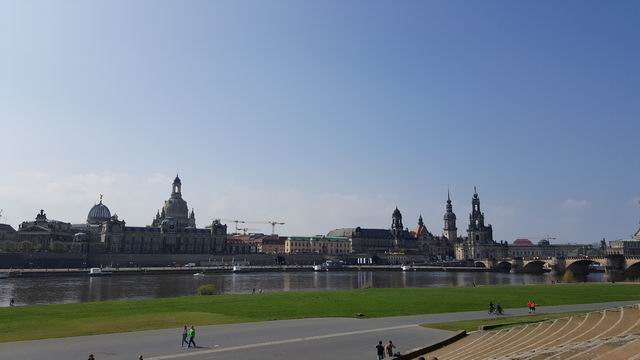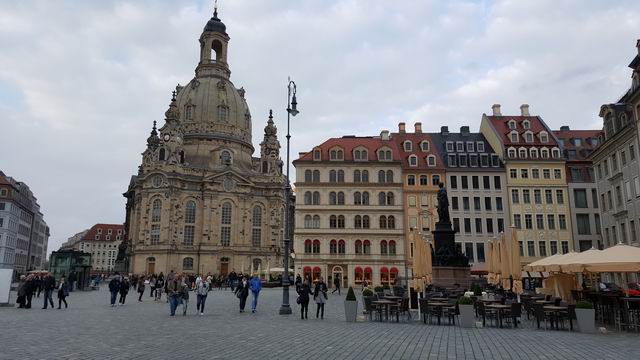

Three good reasons to visit Dresden: watching the rebuilt city after the horrifing bombardements in WW II, the Dresdner Dampflokfest 2017, and Alte Gamälde Galerie in the wonderfull restored Zwinger. A visit in april 2017 with all kinds of weather, delicious sushi, and memories to cherish.
 |
 |
|
view of the restored city across the Elbe-river |
Restored Frauenkirche |
|
Exceptionally beautiful Zwinger, now museum |
Alte Gamälde Galerie in Zwinger building - what a fine place for art... |
--------------------------
Dresdner Dampflokfest, edition 2017
----------------------------
Old city
All of these buildings were more or less destroyed after the bombardement of February 13, 1945. The restoration took more than 50 years...
Semper Oper (Opera building) |
||
Frauenkirche, symbolic for de destruction and reconstruction |
||
Budapester Strasse |
A few words on the bombing of Dresden. See the link to WikiPedia for a neutral stance and bare facts. That is, off course, the best stance. However, a personal opinion is my perogative here.
In war, rules of conduct often do not apply. When there is a situation of life or death, me or him, revenge, loss of control, or whatever uncontrolled emotion, all reason will be lost. Feelings of regret afterwards are out of place. Things have happened. The die is cast. However. When the Americans considered using the atomic bomb on Japan, Kyoto was scrapped from this list for the reason that this city is of a unique cultural heritage of mankind. Comparing Dresden to Kyoto is questionable, but I make this comparison here: Dresden was, with Kassel in central Germany, considered to be the two most beautiful German cities. Why had the Americans themselves persuaded by the English to use Dresden as a target for an awful destruction while the war was virtually over ? Sheer revenge? Retaliation? It happened, Dresden virtually vanished. I conclude that the Americans were more reasonable, more humane, more idealistic, more seeing through the war, and past it. And yet, The English are not just barbaric. It was them who donated the gilded cross on top of the Frauenkirche after its reconstruction in 2004 as a symbol of reconciliation between England and Germany. It happened. And at present (2017), times are good. Dresden is alive, so is Coventry. And Dresden is firmly on the tourists map including that of Asian tour groups.
-------------------
A day out to Schloss Moritzburg in the vicinity of Dresden
further reading::
Matthias Gretzschell, Als Dresden im Feuersturm versank, Published by Ellert & Richter Verlag, ISBN9783831901753. Impressive, interesting book, strongly written. The first chapter starts with the words: Wer Wind sät... That means as much as You will reap what you sow - pointing at the barbaric bombardments the Germans carried out on English cities like Coventry, Middlesborough and London in WW II.
Horst Ziethen, Dresden, Barock- und Kunststadt, Published by Ziethen-Panorama Verlag, ISBN 9783934328891. Picture book with explanatory text. A book with the kind of pictures that surpasses those you made yourself.
https://en.wikipedia.org/wiki/Bombing_of_Dresden_in_World_War_II
https://www.schloss-moritzburg.de/de/startseite/
-----------------
(***note ***) About scrapping the city of Kyoto from the list of potential targets for an atomic bomb. General Leslie R. Groves, head of the Manhattan Project, installed a commision to name potential targets for use of an atomic bomb in early Spring 1945. The commision came with 4 names: Kokura, Hiroshima, Niiagata,and Kyoto. The American minister of war, Henry L. Stinson, demanded Kyoto to be scrapped from this list. He had visited this city in the past, and compared it to Rome in Italy. He found president Truman on his side, and thus agreed to exchange the target of Kyoto for the target of Nagasaki. Source: Wolf Kielich, Bericht van de Tweede Wereldoorlog, copy number 94, page 2621-2622. Published by De Geillistreerde Pers N.V. Amsterdam 1971.